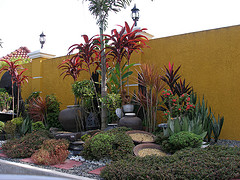
flickr.com/kamoteus
If you’re planning to recreate your landscaping design, don’t think ‘flat’. By incorporating elements of height, you can layer your landscape and bring new excitement to your existing gardens.
While gardening is a great way to clear the mind and soothe the soul, garden landscaping can, of course, get your imagination working overtime and let your creativity run wild. It’s fun to plan and to implement all of your wild designs.
When you layer your landscape beds, you will be adding a completely new level of beauty to your property. Your yard is the first thing that people see when they visit your home, and it’s exciting to cap a home visit with a grand tour of a really gorgeous garden. Taking the effort and time to create striking landscaping will make you the talk of the neighbourhood — for all the right reasons.
It’s, in fact, quite easy to layer your landscape. First, pick the flowers and plants that you really want to have, and study their planting requirements and growing habits. Echinacea, for instance, comes to you as a six-inch plant, but can grow to an impressive six feet tall! This planning stage is, of course, crucial to the success of your landscape design. Make sure to position taller plants behind shorter ones. This may seem clear, but it really does help to make a rough sketch of where you want your plants to be. Then, with drawing in hand, you’ll see it is much easier at the planting stage. Your project will progress more quickly and with fewer troubles.
Three layers are best for creating a truly interesting landscape. If possible, the back row should face north and must include the tallest varieties of plants. As the rows descend, the height of your flowers and plants will follow, as well. Again, this can be tricky when you’re purchasing young plants from the nursery. Study each variety and make out how tall it will be when fully grown. Later, as your garden begins to thrive, you may find that plants growing too tall in the front or middle rows will need to be transferred at the back.
Another essential consideration in your landscape design is the individual growing conditions of each variety. Some plants, such as ferns, thrive in moist, shady conditions and should not be grouped with varieties that require direct sunlight. Some flowers get a boost from high concentrations of fertilizers, while others can actually be harmed by the same treatment. Know the needs of your plants, and arrange them accordingly.
If you want to create a truly interesting and stunning garden, you need to look beyond the horizon. Layer your landscape and bring a fresh dimension to the beauty of your property.
Tagged with: gardening tools • landscaping ideas
Filed under: Landscaping
